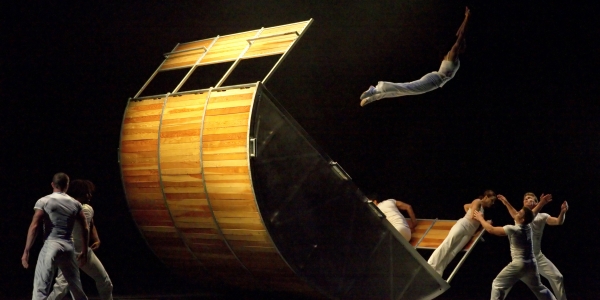After performing flash mob type theatre on the streets in his native Paris, the ‘choreographer/sculptor/designer/architect moved to the US and fell into dance classes because dance didn’t involve speaking English. Those early classes led to Heim falling in love with pure movement. “It’s a universal language,’ he notes, and then is quick to point out that his love of movement is on equal par with his love of architecture; they are as important as each other in what he brings to the stage. Heim formed Diavolo Dance Theatre in the early ’90s, going on to have a massive impact on the US dance scene with work he likens his work to a cinematic experience as it’s so strongly dependent on imagery. “Our work is not circus nor is it ballet or traditional or modern dance. I don’t have a lot of background in dance,” he says. “I was never a gymnast or a dancer in a major company or an acrobat. When I work outside Diavolo Dance Theatre, people think ‘who is this guy? How is he going to direct us? It’s the same with my own dancers. They look at me with a very strange eye.’”
How does this dependence on built environment work in performance? “It’s about our relationship and interaction with architecture,” Heim answers. Are there any places in particular that have inspired him? “My work is never site specific. The structure comes first. Then it’s what the human body does in the environment.” To create a work, Heim creates a structural space, starting with his own drawings, working on a model then working with an engineer to build the set. This can take up to a year. Only then does he bring in the dancers, a team of five women and five men. “They are like children in a playground,” he explains. “I say, ‘go and play on it’. My dancers are choreographing the piece. They show different qualities of movement. I might say ‘I see a floating movement, or move like a snake at a low level; take half an hour then come back and show me what you’ve got.’ The human body brings in movement, mood, motion, light, colour and texture.” What about music? This is dance, after all. “Music comes last,” he says.
Melbourne is about to see the result of this singular process as Diavolo will perform two works, Trajectoire and Transit Space, both inspired by urban landscapes, as part of the show Architecture in Motion, which will be performed at the Arts Centre’s State Theatre in early February. “The pieces are very abstract,” Heim says. “There are themes of imbalance: what we do on stage is alive and into that we bring struggle, fear, chaos, danger, survival, destination, continuation, community, family. These are themes that come up in all the pieces by Diavolo.” Most of the important things in the repertoire of human experience, then.
It was a visit to a sculptor’s studio that got Heim thinking about the performance that has become Trajectoire. “Trajectoire is more about the shapes,” he continues. “I was thinking about the arc, the arch, and how we relate to that.” Those early imaginative wanderings culminated in a performance that could almost be described as a sea voyage on stage with performers negotiating a rocking galleon type structure. The second piece, Transit Space, works as a metaphor for adolescence and uses the culture of skateboarding in Southern California as its starting point in exploring transitions from youth to adulthood. There’s a link between Transit Space and the Australian play The Stones, for which Heim designed the set: the choreographer was intrigued by the story of two Melbourne youths charged with manslaughter after hurling rocks from an overpass and killing a motorist; this led him to explore the adolescent experience more deeply in Transit Space. You could almost say he’s bringing the story home.
The demand on Diavolo dancers is extreme. Word has it that staff at the local hospital near their studio are on first name basis with performers as they see them so often. Heim says it’s ‘hell’ choosing his dancers: auditions can take from eight to ten hours and his performers need to be skilled in various disciplines and be very strong. “It is most difficult. They need to be very strong with upper body and lower body strength. There is a lot of physical repetition and manipulation on a day to day basis. They need a good memory, a great sense of creativity, a little bit of ballet, a little bit of modern dance, a little bit of martial arts, a bit of hip hop, bit of science, a logical side, and a great sense of improvisation. Our work is happening in a cross-fusion of movement. Do I have dancers or gladiators? They are a mix of both!”
BY LIZA DEZFOULI







